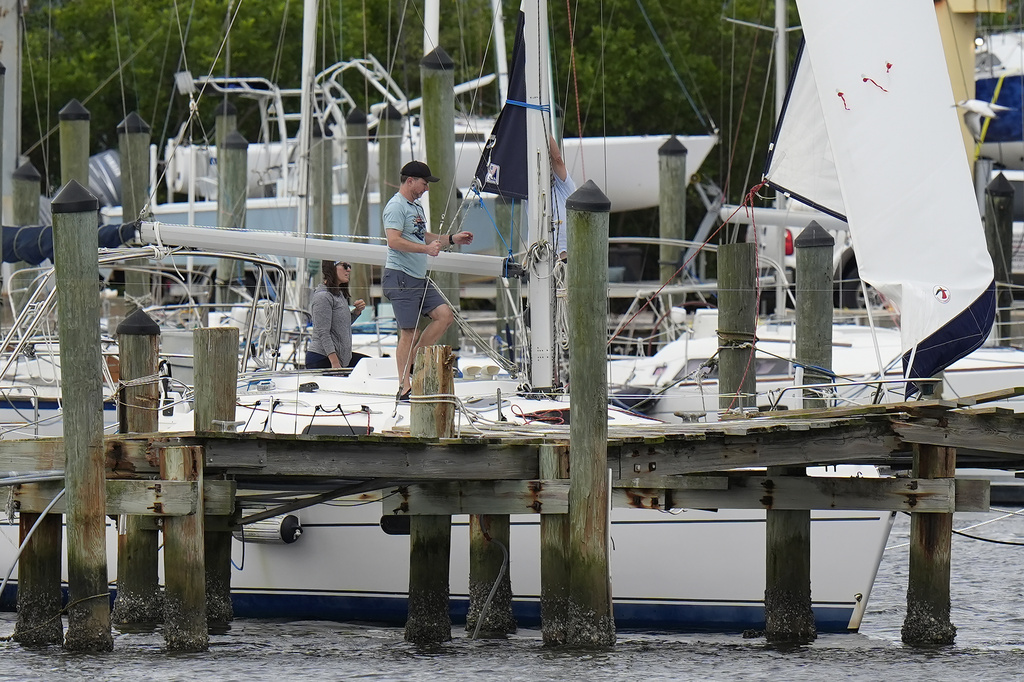Hurricane Milton Intensifies to Category 5, Threatens Tampa Bay \ Newslooks \ Washington DC \ Mary Sidiqi \ Evening Edition \ Hurricane Milton has intensified into a Category 5 storm, threatening Florida’s Gulf Coast and the densely populated Tampa Bay area with a direct hit. Coming just two weeks after Hurricane Helene’s devastation, Milton poses an even greater threat with its powerful winds, dangerous storm surge, and torrential rain. Authorities are urging evacuations as Milton approaches landfall, which is expected on Wednesday.

Hurricane Milton Threatens Florida: Quick Looks
- Hurricane Milton rapidly intensifies to Category 5, targeting Florida’s Gulf Coast.
- The Tampa Bay area, home to over 3.3 million people, is bracing for its first direct hurricane hit in over a century.
- Florida authorities are organizing evacuations, with airports and essential services shutting down in anticipation of the storm.
- Milton’s impact could include life-threatening storm surges of up to 12 feet and heavy rainfall across the state.
- This comes just weeks after Hurricane Helene caused extensive damage across the same coastline.
Deep Look:
Hurricane Milton, a monstrous Category 5 storm, is set to strike Florida’s Gulf Coast, sending shockwaves of anxiety through the region just days after Hurricane Helene ravaged the area. Milton, with its terrifying winds and potential for widespread destruction, threatens the densely populated Tampa Bay area, putting over 3.3 million residents at risk of a direct hit. Florida, still reeling from the devastation caused by Helene, is now scrambling to prepare for another potentially catastrophic hurricane.
When Will Hurricane Milton Make Landfall?
According to the National Hurricane Center’s Live Hurricane Tracker, Milton is projected to make landfall on Florida’s west coast on Wednesday. Though it is expected to weaken slightly to a Category 3 storm before it hits, Milton will still bring intense winds, dangerous storm surges, and heavy rain to the state. The storm’s projected path will take it across central Florida toward the Atlantic Ocean, potentially impacting other parts of the state as it moves eastward.
Milton’s imminent landfall is particularly concerning for Tampa Bay, a region that has not seen a direct hit from a hurricane in over 100 years. The Tampa Bay area is especially vulnerable to storm surge flooding, and with Milton predicted to bring record-breaking surges, the impact could be devastating. The National Hurricane Center has warned that the storm could also retain hurricane strength as it crosses the state, bringing more destruction as it heads toward the Atlantic.
Milton’s Current Status and Path
By Monday afternoon, Hurricane Milton had intensified to a Category 5 hurricane over the eastern Gulf of Mexico, with maximum sustained winds of 180 mph (285 kph). Florida Gov. Ron DeSantis, in a press briefing, described the storm as far stronger than initially predicted. With its eye positioned approximately 675 miles (1,085 kilometers) southwest of Tampa, Milton is moving quickly toward Florida’s coastline, with little time for residents to prepare.
Milton’s rapid intensification took many by surprise. Initially forecasted to be less severe, it developed into one of the most powerful storms of the season in a matter of days. The National Hurricane Center is closely monitoring the storm, and emergency management teams are advising residents in low-lying and coastal areas to evacuate.
What is the Damage Forecast?
Hurricane Milton’s destructive potential extends beyond its ferocious winds. One of the biggest threats is the predicted storm surge, which could bring catastrophic flooding to Florida’s Gulf Coast. Storm surges occur when hurricanes push large amounts of seawater inland, creating dangerous flood conditions. The Tampa Bay area is especially prone to this kind of flooding, and Milton is forecasted to bring the highest storm surge levels ever predicted for the region—between 8 to 12 feet (2.4 to 3.6 meters), nearly double what Hurricane Helene brought just two weeks ago.
Maria Torres, spokeswoman for the National Hurricane Center, stressed the severity of the surge forecast, calling it “the highest ever predicted for Tampa Bay.” During Hurricane Helene, which made landfall in the Florida Panhandle 150 miles (240 kilometers) away, surges still managed to reach 5 to 8 feet (1.5 to 2.5 meters) above normal tide levels, resulting in several drowning deaths in the Tampa area. With Milton predicted to make a much closer impact, the potential for fatalities and widespread damage is considerably higher.
In addition to the storm surge, forecasters are warning of heavy rainfall and the possibility of widespread flooding. The storm is expected to bring 5 to 10 inches (13 to 25 centimeters) of rain to mainland Florida and the Florida Keys, with isolated areas possibly seeing up to 15 inches (38 centimeters). Flash flooding could result from this intense rainfall, especially in areas already saturated by Helene’s downpours. Milton’s path across central Florida may spare the states further north that were heavily impacted by Helene, but central and eastern Florida remain at high risk.
Evacuations and Airport Closures
As Hurricane Milton approaches, Florida authorities are urging residents in vulnerable areas to evacuate. Traffic was already backed up on Interstate 75 by Monday morning, as thousands of people fled northward in anticipation of the storm. Emergency management officials have issued mandatory evacuation orders for low-lying areas in Tampa Bay, St. Pete-Clearwater, and other coastal regions.
Tampa International Airport announced that it will suspend all flights starting at 9 a.m. on Tuesday, urging travelers to finalize their plans before the storm hits. The airport also warned that it is not a shelter for people or their vehicles. St. Pete-Clearwater International Airport, located in a mandatory evacuation zone, will also close after its final flight departs on Tuesday. Airlines are canceling flights and adjusting schedules to accommodate travelers leaving the area, but as the storm moves closer, options for evacuation are becoming more limited.
Mexico Prepares for Hurricane Milton
In addition to its threat to Florida, Hurricane Milton is also affecting Mexico’s Yucatan Peninsula. Mexican officials have started evacuating residents from low-lying areas in Progreso, a coastal city of about 40,000 people, as well as from the nearby nature reserve in Celestun, home to tens of thousands of flamingos. Mexico’s National Meteorological Service has warned that Milton could hit between Celestun and Progreso by late Monday or early Tuesday, bringing heavy rains and storm surges to the region.
The coastal city of Progreso, a key shipping and cruise port, is particularly vulnerable to flooding. Officials are organizing buses to transport residents to safer areas as the storm nears. Though Milton’s primary impact will be in Florida, its effects in Mexico could still be significant, particularly for the region’s ecosystems and coastal communities.
The Aftermath of Hurricane Helene and Ongoing Recovery
As Florida braces for Milton, the state is still recovering from Hurricane Helene, which made landfall less than two weeks ago. Helene, though weaker than Milton, caused significant damage across the Florida Panhandle and inland areas, leaving behind debris, flooding, and power outages. Crews have been working tirelessly to restore services and clear debris, but with Milton approaching, many fear the worst is yet to come.
Helene claimed over 230 lives during its destructive path from Florida to the Carolinas, and the storm’s aftermath is still being felt in many communities. Emergency shelters are once again being set up, as the state prepares for another round of evacuations. Recovery efforts from Helene will likely be delayed as resources are redirected toward dealing with Milton’s impact.
Looking Forward: The Path Ahead
Florida’s Gulf Coast is on high alert as Hurricane Milton nears, with officials urging residents to heed evacuation orders and prepare for potentially life-threatening conditions. The next few days will be critical as Milton continues to bear down on the region. With its ferocious winds, heavy rain, and record-breaking storm surge predictions, Milton is shaping up to be one of the most dangerous storms to hit Florida in recent years.
As recovery from Hurricane Helene continues, the state is once again faced with the challenge of preparing for and responding to another major hurricane. While it remains to be seen exactly how much damage Milton will cause, the storm’s rapid intensification and destructive potential are cause for serious concern. Authorities are urging residents to take every precaution possible and remain informed as new updates become available.







